Abstract
With the growth of the magnesium recycling market, the risk of fire and explosion has been raised over time. In particular, dross generated in the process of magnesium recycling is not considered as a hazardous material even though it contains a lot of pure magnesium and/or magnesium compounds. There are few safety measures to prevent and respond to potential fires and explosions in the magnesium recycling process and to protect employees. Therefore, this study aims to identify appropriate safety measures to reduce the risk of fire and explosion in the magnesium recycling process by looking at two actual magnesium fire cases and relevant criteria in South Korea, the US, and Japan. Also, a combustion experiment using magnesium powder was conducted to identify the significant combustion phenomena of magnesium. Lastly, we developed a fire safety mechanism of magnesium, including chemical reaction, smoldering, and ignition. Each phase presents five contents for different safety measures in the visibility of combustion reaction, the velocity of the combustion reaction, identification methods, response measure, and possible responders. Although this study focused on dross from the magnesium recycling process, it is expected to be useful to develop a better risk management strategy to reduce the risks in the recycling process of metals.
1. Introduction
Magnesium has been widely applied in various industries, including aeronautics, pyrotechnics, and in the base materials of paints and chemicals due to its lightweight and extreme mechanical strength [1,2,3]. In addition, magnesium is well known as one of the green engineering materials in the 21st century by virtue of the convenience of magnesium recycling [4,5]. As of 2020, the global magnesium alloys market is estimated at USD 2.93 billion and is expected to reach USD 6.62 billion by 2027 [6]. In South Korea, magnesium alloys consumption has gradually increased in the fields of information technology (IT), electrical appliances, and automobiles. According to reports, pure magnesium demand in 2018 was approximately 24,400 tons, while an annual demand of secondary ingots from the magnesium recycling process was roughly 11,800 tons [7,8]. However, magnesium, as a combustible metal, is a significant water-reactive substance and a high-risk metal that easily causes fires and explosions due to magnesium’s lowest melting and boiling point among the alkaline-earth metal groups. These characteristics of magnesium pose serious safety concerns with respect to fires and explosions, if not appropriately managed [2,4,5,9].
There are several causes that trigger a fire and explosion in the magnesium recycling process. The most remarkable reason is a chemical reaction between magnesium scraps containing magnesium oxide (MgO), and dross, which is one of the by-products generated from the process and environmental conditions involving water or high humidity in the air. However, there are no regulations and guidelines that can cover the risks and unexpected accidents from scrapped magnesium storage to re-refining magnesium. Unfortunately, this issue is not only limited to South Korea. For example, there was a total number of 153 industrial accidents caused by water-reactive metals with economic losses of approximately USD 1.6 million between 2016 and 2020 [10]. In addition, in the same period, a total number of 514 fires out of 1587 accidents at the waste and recycling facilities in the US/Canada were reported [11]. Several countries also have been facing the challenges of managing the metallic fires caused in the magnesium recycling plants.
There have been some cases of fires and explosions. In South Korea, an impressive explosion and fire by invalid welding works occurred at a magnesium recycling plant located in Miryang in November 2016 (Figure 1). Four workers died in the accident. After three years, in July 2019, a huge fire took place in the same plant due to a chemical reaction between magnesium dross and high humidity (Figure 2). Even though there was no severe damage to neighboring firms and local communities, the plant burned down due to rapid fire spread and the absence of fire extinguishing agents and proper emergency response. In the US, explosions and fire at a magnesium recycling plant in Michigan in May 2018 occurred and resulted in two injuries. The leading cause of the first explosion has not been discovered yet. However, the second and third explosions occurred by chemical reactions between magnesium and water from a water suppression system in a building of the plant.
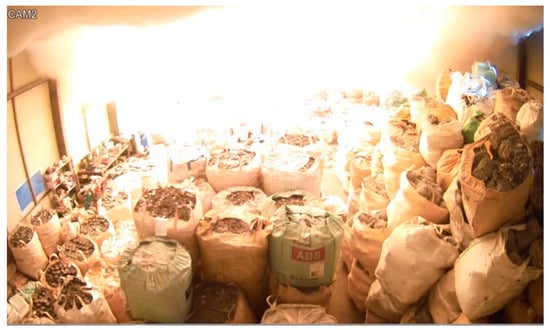
Figure 1.
Dust explosion in a magnesium recycling plant (2016) (Photo by Miryang fire department).
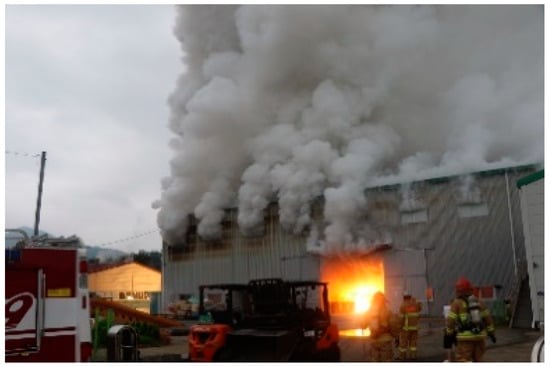
Figure 2.
Fire in a magnesium recycling plant (2019) (Photo by Miryang fire department).
In recent years, the risks of magnesium fire and explosion and their accident cases have been studied. Most academic works mainly focus on dust explosion regarding the minimum ignition temperature (MIT), the minimum ignition energy (MIE), and the maximum pressure (Pmax) in consideration of particle size and environmental conditions from the macroscopic perspective [12]. However, the risks of fire and explosion occurring in the magnesium recycling plants and their applicable safety measures are still overlooked.
Therefore, the aim of this study is to identify safety measures to prevent and respond to fire/explosion in the magnesium recycling process. We reviewed relevant national and international regulatory instruments to explore safety measures and a few major accidents which occurred in South Korea. Also, a combustion experiment using field-emission scanning electron microscopy (FE-SEM), energy-dispersive X-ray spectroscopy (EDS), and X-ray diffraction (XRD), was implemented in order to investigate thermal properties and determine safety measure factors for fire suppression and responders. Based on the overall results, we propose a fire safety mechanism with alternative safety measures to reduce the risks of fire and explosion in the magnesium recycling process.
2. Background
This section presents (1) a theoretical background of magnesium fire and explosion, (2) risks in the magnesium recycling process, and (3) international and national regulations for magnesium.
2.1. Theoretical Background of Magnesium Fire and Explosion
The autoignition point of magnesium is lower than other materials when the size of particles is smaller. The temperature is 745.93 K, whereas the boiling point is approximately 1373.15 K, as shown in Table 1. When magnesium is burned, magnesium continues to burn by itself even if oxygen is depleted. Then, it reacts with nitrogen in the air and generates magnesium nitride (Mg3N2). Specifically, approximately 75% of magnesium atoms react with oxygen, producing MgO (2Mg + O2 → 2MgO), and Mg3N2 is synthesized by the direct nitridation reaction of 25% Mg with N2 (3Mg + N2 → Mg3N2) [12,13]. In this ignition process, the temperature is reached up to 3273.15 K.

Table 1.
The physical properties of magnesium.
In general, MgO (melting point: 3125.5 K) is odorless and white and/or off-white, and Mg3N2 appears pale-yellow [2,9]. MgO reacts with water (H2O) and the combination produces hydrogen (H2) gas (MgO (s) + H2O → Mg(OH)2 + H2 ΔH = −81.02 kJ mol−1). Mg2N3 reacts with H2O and the synthesis creates Mg(OH)2 and NH3 gas (Mg3N2 + 6H2O → 3Mg(OH)2 + 2NH3). The severity of the reaction is determined by the water temperature [2]. The reaction of burning magnesium with water can be indicated in two ways (Function (1) and (2)), as follows:
Mg + 2H2O → Mg(OH)2 + H2
Mg + H2O (when it is steam) → MgO + H2
The reaction produces (1) Mg(OH)2, (2) MgO, and, respectively, H2. As water is applied to reduce high temperature from the chemical reaction, magnesium combustion breaks down H2O into H2. Also, water (H2O) is split into H2 and O2 roughly at 2273.15 K [2]. Due to magnesium properties, water can never be applied to fire suppression. In addition, the combustion of magnesium produces ultraviolet radiation and white light emission that can induce outer retinal damage.
Numerous studies have focused on assessing combustion characteristics by evaluating the explosivity of magnesium dust and powder. Only a few studies considered fires of magnesium dust and powder. The explosion of dust and power is sorted into strength and ignition characteristics [14]. Generally, the ignition characteristics are indicated by the explosive range, MIT, MIE, and limiting oxygen concentration (LOC). The strength characteristics are denoted by Pmax, maximum pressure that rises rates (dP/dtmax), and flame propagation speed [15]. NFPA 484 assesses the explosion risk of flammable metal powder and dust with factors, such as MIE, Pmax, dP/dtmax, deflagration index (Kst), LOC, and MEC [16]. Moreover, other studies have addressed explosive properties depending on different particle sizes through analyzing strength and ignition characteristics [4,9,17,18,19,20,21].
Among those characteristics, MIT (K) and MIE (mJ) are particularly essential factors to assess explosive properties and fire risks. Previous studies have shown that the smaller the material particle sizes, the more the MIE and MIT are decreased, which means the risks of fire and explosion increase. For example, Nifuku et al. [4] revealed that when the magnesium particle sizes are 0–20 μm and 149–177 μm, the MIT and MIE is 786.15 K/4 mJ and 898.15 K/242 mJ, respectively. Li et al. [17] identified the MIE of magnesium particles of 6 μm as below 2 mJ. Also, another experiment demonstrated that the MIE is elevated higher than the MIT, and 2 mJ can be easily generated by electric sparks and friction of materials. It means that the smaller the magnesium particle, the greater the increase in the risk of fire and explosion.
In addition, Yuan et al. [18] conducted an experimental study using differential scanning calorimetry (DSC) and thermal gravimetric analysis (TGA) to identify combustion reactions of nitrogen and oxygen gases. In the experiment using a magnesium particle of 6 μm with the rate of temperature rise, 325.15 K/min, the mass of magnesium (%) was slightly increased at 603.15 to 773.15 K. This change indicates initiation of oxidation and nitridation and it rapidly reacts at 773.15–873.15 K. In the reaction, the first peak was 863.15 K and the rapid oxidation was continued until the melting point reached up to 883.15 K. Then, the speed of the oxidation is slowed down until it reaches to 923.15 K. The results presented that the magnesium combustion proceeds in the order of slow-burning until it gets autoignition temperature, rapid oxidation and nitridation, reach up to the melting point of magnesium, and a downturn of oxidation and nitridation.
Theoretically, the magnesium combustion shows burning with flames and smoldering following the melting point [22,23]. When combustible metals, particularly magnesium, are burned, the combustion rate is relatively speedy, but the smoldering continuously takes a longer time. Kudo [22] evidenced that the flame spread rate dramatically increases if the particle sizes are smaller. In addition, the smaller the particle sizes, the thinner the oxidized and melted layers. It indicates that the combustion promptly expanded and transferred the heat can be comparatively delayed if the particle sizes are small, and it spends a longer time until the combustion is overdue to extended smoldering. So far, most studies have explored the burning risks of magnesium by looking at its explosive reactions.
The combustion mechanism of magnesium is obviously different from the explosion’s since the combustion reactions with the flame spread and temperature rise vary depending on melting, oxidation, and vaporization in the burning process and create assorted by-products. Thus, fire risk management of magnesium requires a divergent response measure considering scientifically assessed fire risks, potential ignitors, and understanding the combustion mechanism of magnesium.
2.2. Risks in the Magnesium Recycling Process
Magnesium fires have frequently occurred in the magnesium recycling processes in recent years. Although there are differentiations of the recycling process depending on the countries and recycling techniques, the process, in general, consists of several phases (Figure 3), are (i) scrap charging (Figure 4) and melting; (ii) primary chemical refining; (iii) finance transport; (iv) secondary chemical refining; and (v) ingot casting. Among them, the second and fourth phases, primary and secondary chemical refining, turn out two types of by-products which are well-known as dross. In particular, the primary chemical refining generates white dross that contains 15–70% of pure and oxidized magnesium. The collected white dross is re-refined again to extract magnesium more, and it becomes black dross containing 12–18% of magnesium at the end of the secondary chemical refining. This black dross is not valuable for recycling materials anymore and the dross is landfilled. In the refining process, magnesium particles and/or a small amount of pure magnesium cannot be eliminated. Nevertheless, there are no regulations or guidelines to handle these white and black dross, as hazardous materials. Thus, the magnesium recycling plants are consistently exposed to the risks of fire and explosion.

Figure 3.
Magnesium recycling process.
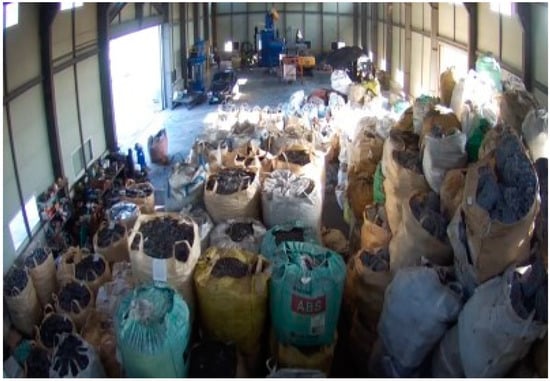
Figure 4.
Scrapped magnesium products.
Among this process, by-products, such as the dross dummy in Figure 5, are generated from magnesium disposal in melting and fusion phases. In particular, this dross is oxidized and nitrated material gathered from the upper part of the furnace in the melting phase. The dross contains magnesium and MgO, which is one of the most dangerous water-reactive states, and the amount of magnesium and MgO is determined depending on operation techniques. It means that the by-products must be practically handled as hazardous materials. As described in the earlier section, magnesium is a slow-reacting substance, but when it reacts with other oxidized materials, particularly water, it shows a violent reaction. Therefore, when water, steam, and/or mist infiltrate into a dross dummy extracted from magnesium disposal, the water reaction is gradually initiated and connected to fire or explosion. This invisible reaction makes a delayed discovery of fire and appropriate response due to the explosive fire spread over dross dummies.
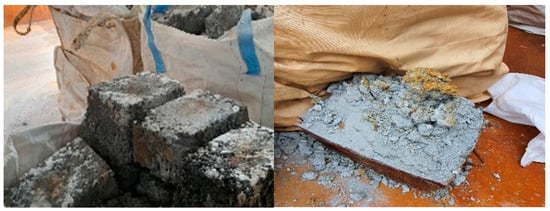
Figure 5.
Dross dummy from a melting process of magnesium.
2.3. National and International Regulations for Managing Magnesium as a Hazardous Metallic Material
Although magnesium recycling facilities literally need to be handled as hazardous facilities, these are simply considered as waste disposal facilities by relevant laws and regulations. For example, in South Korea, the Act on the Safety Control of Hazardous Substances earmarked magnesium for a class 2 hazardous material (i.e., as a combustible material). Moreover, the act explicitly addresses magnesium can be one of the dangerous substances in specific conditions, that the particle size is less than 2 mm and stored over 500 kg. This standard helps to decrease the chances of disastrous fires and explosions in chemical facilities, but it excludes magnesium (i.e., disposals, dross, ingot) in magnesium recycling plants. In addition, the Standard on Fire Protection for Storage of Magnesium released by the Korean Fire Protection Association directs that magnesium dross must be reserved in metal containers with an air vent and a solid safety cover indoor and outdoor. However, the regulations still do not contemplate dross from the magnesium recycling process for a risk factor of fire and explosions.
Furthermore, metal fires are not classified as a specific fire type in South Korea. For this reason, there is no appropriate metal fire extinguishing systems and most metal fires rely on only dry sand and/or expanded vermiculite. The empowerment of using those fire extinguishers belongs to the local government and other organizations, and the extinguishers are usually stored in other places instead of fire stations or chemical facilities. Thus, some issues, such as managing dry sand/expanded vermiculite; delaying first response immediately after fire/explosion; and postponing bringing those extinguishers, are urgent to be solved. As a result, firefighters often adopt a strategy applying spontaneous extinguishing that they observe the fire until metals in the burning entirely burn to ashes.
In Japan, flammable metals, such as aluminum and magnesium, are generally categorized as a class 2 combustible solid of hazardous materials by the Fire Service Act. According to a relevant regulation by the Ministerial Ordinance on Standards for Verification concerning Industrial Wastes Containing Metals, magnesium used or recycled is handled as the type of industrial waste, not hazardous materials. We know that aluminum and magnesium, regardless of whether they are produced or unproduced, are dangerous due to the risk of ignition by water or humidity. However, the other regulation, Ministerial Ordinance to Provide the Technical Standard on Fire Extinguishers, does not consider metal fires in the fire classification system. Despite the high risks of combustible metal, the existing regulations show that there is still a need for appropriate classes of fire and legal guidelines to manage such combustible metals.
There are some examples of combustible metal fires and explosions in Japan. Between 1987 and 2015, 28 and 19 fires and explosions cases of aluminum and magnesium recycling plants respectively have been reported [21]. Over these accidents, the governmental organization has tried to reduce the risks of fire and explosion in the plants. The Japanese Fire and Disaster Management Agency released a manual for safety management of magnesium, etc., in 2016 [24]. The manual incorporates various types of information, such as magnesium properties, guidance for fire preparedness and response, and the risks of magnesium in the producing process, preservation methods, and fire extinguishments. Particularly, the manual proposes applying various extinguishers, such as dry sand, flux for magnesium, perlite, agents for metal fires, to suppress fires in the early stage. It also involved accident cases yearly reported from the magnesium industry to obtain the lessons learned from actual accidents.
In the United States (US), the Occupational Safety and Health Administration (OSHA) addresses the distance between any extinguishing agent and the working area handling the combustible metals needs to be 75 feet (22.9 m). The firms using combustible metals, such as powders, flakes, and shavings, must prepare portable fire extinguishers for Class D fire. According to an OSHA report [25], magnesium is categorized as a toxic metal, and the permissible exhale limits (PEL) of magnesium oxide fume, which is generated by combustion, is 15 mg/m3. These guidelines demonstrate that magnesium must be managed by strict standards due to the risks of fire and explosion and harmful effects on the human body. Further, NFPA 484: Standard Combustible Metals published by the National Fire Protection Association (NFPA) considers pure metals and alloys together as combustible metals and categorizes them into five groups: alkali metal, combustible metal, legacy metal, metal alloy, and metal-containing mixture [16]. NFPA also provides the specific criterion for judging combustible metals, evaluating dust explosion risks, informing firefighting activities, and applying adequate extinguishers.
3. Recent Fires and Explosions in a Magnesium Recycling Plant in South Korea
There were two cases of fires and explosions at a magnesium recycling plant located in Miryang, the southern part of South Korea (Table 2). The first accident, a dust explosion and fire, occurred by a human error in November 2016. Incautious welding ignited magnesium dust in scrapped magnesium dummies in a warehouse building. The explosion was expanded to other structures that contained magnesium scraps, dross, and ingots. It also caused a massive fire, burnt down all plant buildings, and developed to neighboring firms’ facilities. Due to this accident, four workers in the plant died. Firefighters had to use 100 tons of dry sand that the local government provided, and it took about two days until the fire was completely suppressed.

Table 2.
Cases of magnesium fire and explosion.
The second case occurred in July 2019. The fire was started with smoke in a magnesium dross dummy (Figure 6a). A worker reported the fire to the authorized fire department as soon as the smoke coming out from the dummy was discovered. Unfortunately, there were no available extinguishers at the plant until the arrival of firefighters. Later, firefighters tried to suppress the fire with dry sand that was equipped in the plant, but the fire was drastically expanded, and their efforts to cope with the accident failed (Figure 6b). After that, firefighters obtained extra dry sand from the local government that same day. However, the fire had already spread to entire plant buildings, so they could apply only a preventative measure not to extend the fire to other facilities nearby the plant. Lastly, firefighters adopted an intuitive extinguishing method since the initial response failed, and the fire continued until 31 July (Figure 6c).
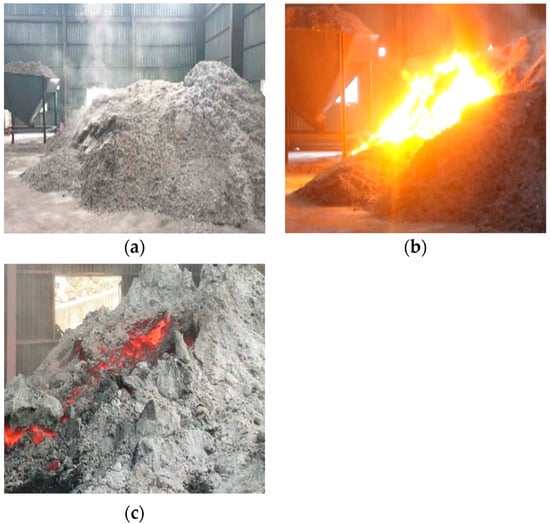
Figure 6.
A combustion process of magnesium dross obtained from the Miryang accident. (a). Pre-smoldering with smoke. (b). Rapid expansion of the fire. (c). Post-smoldering (decline stage).
Although the ignited materials were magnesium scraps and dross in two cases, the fires presented similar fire patterns with the combustion process of pure magnesium entailing intense light, high temperature, and flames, and a long-term smoldering phase. It also implies a need for particular response measures to suppress magnesium fire. In both cases above, common limitations of fire extinguishers and response measures were identified. Particularly, smoldering must be observed consistently to investigate fire conditions since the combustion continues for a while and suddenly spreads. On the other hand, if a spontaneous extinguishing method that leaves the fire until it burns down is applied without any extinguishers, safety measures must consider other external hazards (i.e., weather changes, environmental conditions). With these issues, this study performed a magnesium combustion experiment and analyzed by-products from the magnesium combustion that would be observed in general magnesium burning and a spontaneous extinguishing.
4. Experiment Methods: Materials and Setup
The rate, size, shape of magnesium dross containing pure magnesium are all different depending on the magnesium recycling process stage where the dross is produced. This is due to the fact that the recycling plants have their own techniques for earning magnesium dross in operation. Thus, this study supposed that it is difficult to control those variables of dross and to obtain unambiguous results from an experiment.
Based on the limitation, we determined to use magnesium powder, which must be contained in magnesium dross, to explore preventative and responsive measures against magnesium fires, as combustible metal fires, in the magnesium recycling process. As mentioned earlier, there are no appropriate guidelines for combustible metals. Thus, we designed our experiments adapting ISO-7165 firefighting—portable fire extinguishers that mainly demonstrate a functional test of different fire extinguishers. Also, it describes how to conduct successful experiments for fire extinguishers of metal fires by employing actual materials. In particular, ISO-7165 suggests using 18 Kg of magnesium chips or 11 Kg of magnesium powder (purity > 99% and particle < 150 μm) for testing 30 lb of fire extinguishers for metal fires. Figure 7 shows the test equipment designed with a fuel bed and baseplate.

Figure 7.
Experimental equipment design and mockup.
4.1. Samples
For this magnesium fire experiment, the type of magnesium was selected referring to ISO-7165, which is the Standard for Class D Fire Extinguisher of Chemical Powders. We prepared 11 kg of magnesium powder (purity > 99% and particle < 150 μm), which was dehydrated in a desiccator for 24 h (296.15 ± 278.15 K), as shown in Figure 8. Also, Figure 9 presents two FE-SEM images of the magnesium powder used in this study, which have round and irregular shapes.
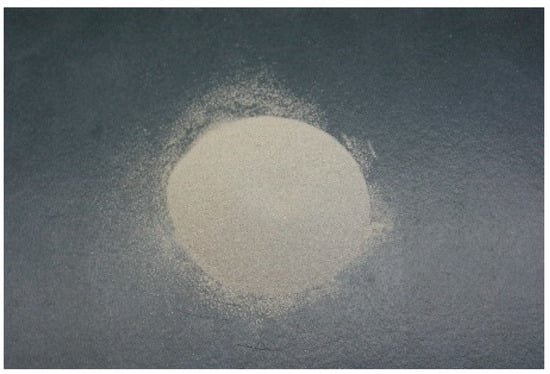
Figure 8.
Magnesium powder used in the experiment.
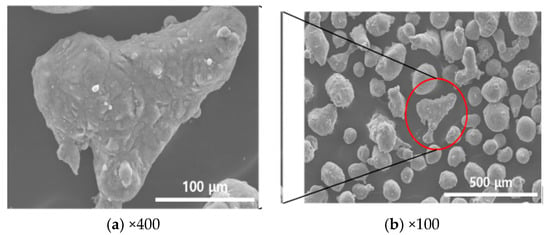
Figure 9.
FE-SEM images of magnesium powder used in different magnifications, ×400 (a) and ×100 (b).
4.2. Experimental Setup and Method
The experimental equipment was layered-structure as follows: an inner frame (600 mm (Length: L) × 600 mm (Width: W) × 300 mm (Height: H)) and an external frame (1000 mm (L) × 1000 mm (W) × 300 mm (H)) is placed on the plasterboard (1000 mm (L) × 1000 mm (W) × 300 mm (H)), as shown in Figure 10. The prepared magnesium powder was poured into the inner frame. We used a thermal infrared camera (IR camera, model: Testo 890, 245.15–1475.15 K of thermal range, 7.5–14 μm of spectrum range) to distinguish heat distribution and evaporation on the surface of burning magnesium powder. Also, a digital video recorder was applied to observe the overall phenomena and progress of magnesium powder combustion. In order to analyze the combustion by-products, SEM (model: S-4800 made by Hitachi) with energy-dispersive X-ray spectroscopy (EDS) was used at an acceleration voltage, 10–20 kV. Although 11 points of thermocouples were installed, we did not include the results of thermocouples in this study since some errors caused by the extremely high temperature were detected.
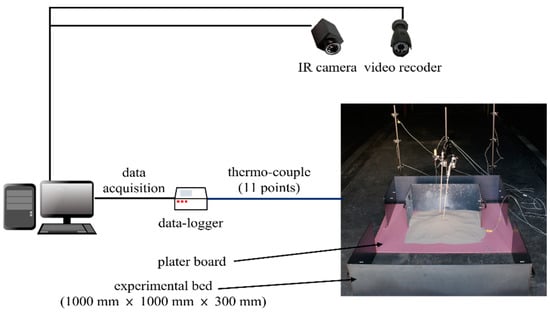
Figure 10.
Set up the experiment equipment.
The experiment was conducted inside of a facility equipped safety guard in order to control the external environmental conditions conveniently. The procedure is as follows: (1) set up the experiment equipment on a flat ground; (2) pour 11 Kg of pure magnesium powder on the plasterboard of the experimental bed; (3) ignite the middle areas of the magnesium powder dummy using a gas torch for 30 s (s); (4) leave the burning magnesium powder dummy until it is suppressed by itself; and (5) collect by-products from the internal and external area of the burned sample. In addition, we prepared safety measures, such as fire extinguishers and personal safety devices to prevent possible accidents.
5. Results
We analyzed the magnesium fire mechanism and its by-products with obtained data. As igniting the magnesium sample, temperature distributions of burning magnesium powder were observed and estimated using an IR camera. Figure 11 shows that the temperature of the burning magnesium powder is 789.5 K at the beginning that is observed as soon as the dummy of magnesium powder is ignited. It took approximately 2 min (min) 20 s until the temperature reached up to 1473.6 K, which is the maximum detectable temperature of the IR camera. After about 23 min, the temperature gradually declined. In our other experiment under the same conditions, the temperature was elevated up to 1473.6 K at the beginning, which took about 2 min 11 s [26].
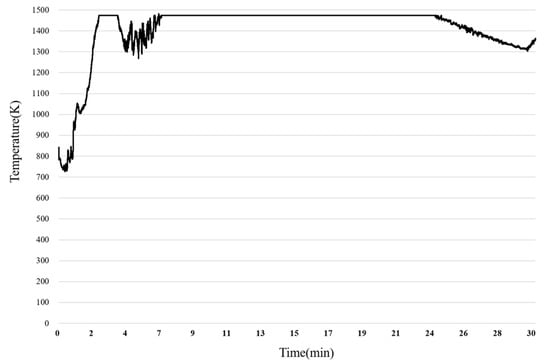
Figure 11.
Temperature changes during the magnesium powder combustion.
Figure 12 describes the combustion process of magnesium powder depending on the elapsed time. Immediately after igniting the material, the combustion was slowly launched with pink flames. Since 180 s, drastic fire spread accompanied by the bright white flames were observed that produced gases through the dynamic combustion. This magnesium powder combustion on the surface mainly remained by-products appearing white color. The combustion without flames continued inside of the dummy of the powder. While the significant reaction was burning with flames for 360 s (Figure 12c), the reaction is divided into burning with flames and with melting from 540 s (Figure 12d). Figure 12e indicates clearly separated reactions, burning with flames and without flames in 720 s. Figure 13 shows that there are temperature differences in the areas of the burning with flames and melting. The figure illustrates that the upper side started with the burning surface with flames and turned quickly into the combustion entailing melting reaction. However, but the lower side of the burning point shows delayed combustion reactions with flames.

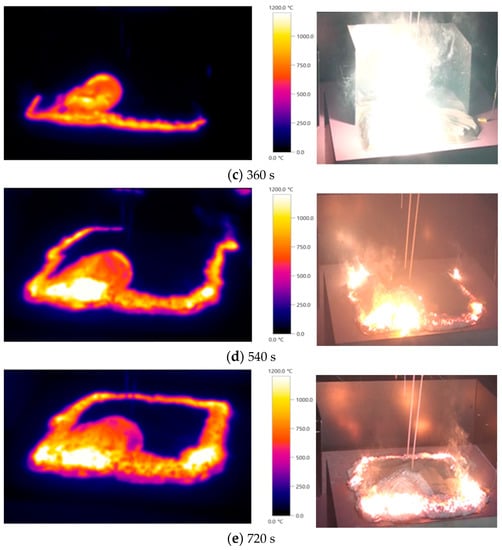
Figure 12.
Temperature distribution of magnesium combustion over time (a–e).
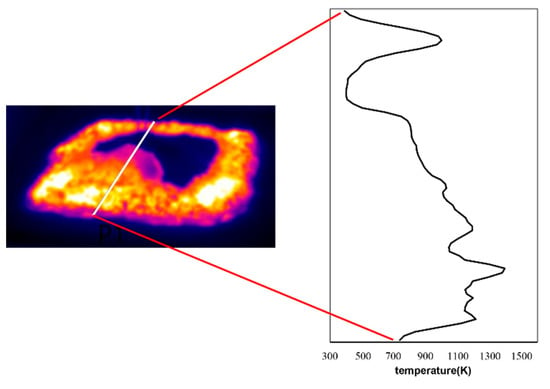
Figure 13.
Detected temperature distribution of burning magnesium powder in 720 s.
The combustion by-products of magnesium powder created fragile white solid objects on the surface, that is MgO, and coagulated grey objects under the burned surface, as shown in Figure 14. This coagulation is considered as one of the melting phenomena that transfer heat from the inside surface during the burning of magnesium.
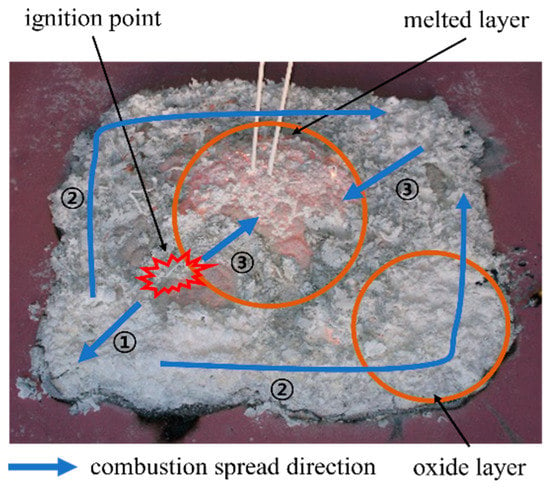
Figure 14.
Combustion directions on the by-products of magnesium.
Moreover, Figure 14 demonstrates the combustion progress, that is proceed in order of number from ①, ②, and ③. While magnesium power is burnt toward a direction ① from the ignited spot, where it is thinner than other areas, the combustion with flames are expanded to number ② directions (the edge of magnesium dummy), the most major combustion reaction was melting in the direction of ③. The ash of burnt magnesium proves where there was the combustion with flames by showing the white MgO and grey color of carbide magnesium surrounding ① and ② areas.
The combustion on the surface spread to the bottom part of the powder dummy. It means that magnesium in the experiment was burnt from outside rapidly, where the amount of magnesium was more petite, to inside slowly, where magnesium was heavily filed up (since the magnesium combustion continues to burn inside without flames by itself at the end of the surface combustion, thereby bringing flames).
The by-product analysis using SEM and XRD presented the differences in the inner and external samples. Figure 15 illustrates where the ignited area from the remained ash of magnesium power. The area (a) and (b) are magnified in Figure 16 using SEM. However, compared to the circled and irregular shapes in the pre-combustion of magnesium, the samples appear in varying forms. The sizes of observed particles are diminished by 1–50 µm. Furthermore, the particle shapes of interior and exterior by-products were irregular but similar due to the same original form and chemical transformation. Namely, there is no unique difference from the transformation of magnesium particles by high temperature heat of the combustion.
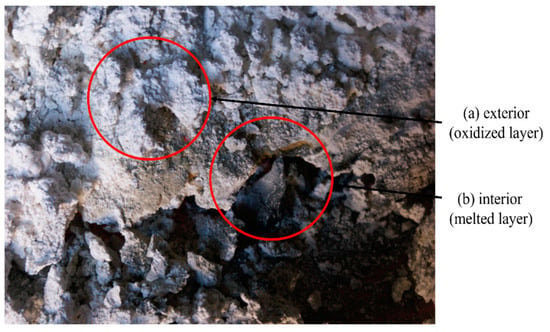
Figure 15.
Ignited spot’s by-product.

Figure 16.
SEM imaging of carbonated magnesium from the interior (a) and exterior (b).
Figure 17 illustrates spectrums of component analysis of the interior (a) and exterior (b), which are from (a) and (b) in Figure 15, which detected Mg, O, and Pt. As Pt was used to increase the frequencies of secondary emission, it was excluded from the analysis of the products. We collected and analyzed the samples of interior and exterior by-products of the combustion residues. It turned out the interior samples contained an average of 52.72% of O and 47.28% of Mg (Table 3), whereas the exterior samples contained an average of 58.92% of O and 41.08% of Mg. The results imply that the external combustion has broader dimensions contacting with oxygen, as Mg from the exterior products was approximately 6% higher than of the interior ones. In addition, the oxidation reaction occurs on the surface of materials and burning with melting reaction starts from inside of the material.

Figure 17.
Electron images and spectra graphs of magnesium combustion’s by-products from the interior (a) and exterior (b).

Table 3.
Rate of the interior and exterior by-product of magnesium.
Figure 18 shows the XRD patterns of the carbonated magnesium. It indicates the XRD diffraction analysis of the carbonated samples. In the interior and exterior of burnt materials, Mg, MgO, Mg(OH)2/Mg, MgO, Mg3N2/Mg(OH)2 are synthesized. MgO was detected in the interior and exterior of the by-products; Mg3N2 was observed only from the exterior samples of magnesium powder. Mg3N2 and O2 reacted vigorously during the combustion process, which generates MgO and NH3 (Mg3N2 + 3H2O → 3MgO + 2NH3). However, NH3 was not detected during the XRD analysis. Mg(OH)2 can be produced by the direct reaction between Mg and H2O, in general, in the chemical reaction formula (2Mg + 2H2O → Mg(OH)2 + H2). At room temperature, Mg gradually reacts with H2O. However, if the water temperature increases, Mg and H2O react violently and generate H2 that potentially induces hazardous conditions. This study assumed that Mg(OH)2 was generated by reacting with H2O in the combustion process or storage. Produced Mg(OH)2 presented that H2 also can be generated in other ways. Moreover, it signifies that the safety measures for magnesium powder must be considered in the recycling process or storage management. The results of this study show that there is a need for investigating the generation mechanism of Mg(OH)2 by conducting repeated experiments.
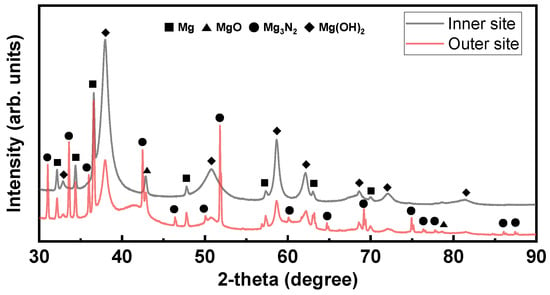
Figure 18.
XRD diffraction pattern of magnesium combustion’s by-products. Indexed according to JCPDS cards: 00-035-0821 (magnesium), 01-084-2164 (magnesium hydroxide), 01-071-2640 (magnesium nitride), and 00-004-0829 (magnesium oxide).
6. Discussion
The causes of fire and explosion in the magnesium recycling process are classified into ignitors and water (or moisture in the air). This study presents that the fire caused by ignitors induces a rapid expansion. On the other hand, the fire triggered by water or humidity goes on longer due to the smoldering following a slower reaction with water. The burning mechanism accompanies with oxidation and nitration on the surface of magnesium and the melting reaction inside. Through the XRD analysis on the by-products, we identified different reactions inside and outside of the magnesium combustion. It implies that the more the magnesium particle is tiny and present in a large amount, the more the melting status inside is extended and profound. It also indicates that the retarded combustion reaction influences the total duration of burning.
This study explored the elements for fire recognition and quick response. This requires dividing into pre-and post-burning reactions of magnesium with either flames or no flames. Since the burning patterns are entirely changed in the two stages, the magnesium recycling plants must need to prepare fire recognition skills, first response capacities, and well-trained workers and appropriate devices to reduce the chances of potential fires and damages.
Comprehensively, based on the case study and an experiment, a magnesium fire mechanism was structured, as shown in Figure 19. The mechanism consists of two pre-combustion phases, including chemical reaction and smoldering, and actual fire, involving growth, full development, decline. The stage of a chemical reaction is of generation and accumulation of heat by chemical reactions between Mg, MgO, and so on, within the dross dummy by moistures or water. The smoldering stage generates non-flammable smoke by the accumulated heat from the reaction stage. Here, the flame is simultaneously emerged inside of the dross dummy and begins pouring out. Stage 3: fire includes growth, full development, decline presents the actual combustion with flames. In the beginning, combustion with violent flames is initiated on the surface, and then it moves to the inside of materials. Finally, the end stage of burning is continued in the way of smoldering without flames.
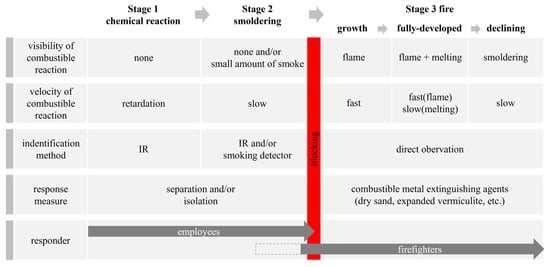
Figure 19.
Fire safety mechanism of magnesium dross generated from the recycling process.
According to the developed fire safety mechanism of magnesium dross, an appropriate way to minimize the effectiveness and impact of magnesium fire is to impede progress between the smoldering and fire stage. The velocity of the combustion reaction is relatively retarded in the smoldering stage. On the other hand, in the fire stage, violent combustion reaction with flames aggressively is expanded, generating high temperature heat and by-products such as toxic gas and harmful ultraviolet rays. It hinders quick access to the fire scene and the most effective firefighting. There is little evidence of the combustion reactions that can be detected easily, but white smoke is visible in the smoldering and it turns to the fire stage with flames. The fire stage ends up smoldering again. Therefore, it is difficult to identify starting the magnesium burning and catch an accurate time to respond to the fires in the recycling plants. Thus, potential damages can be curtailed by isolating magnesium dross, which is proceeding combustion, to prevent fire spreading to other combustible materials. Moreover, covering the burning magnesium dross using dry sand, expanded vermiculite, and other extinguishers for metal fire is a requisite preventive measure to suppress flames or heat during these transition stages.
Furthermore, the immediate firefighting activities at work by the employees who found the smoldering or fire is a requisite response until the arrival of professional firefighters. Considering a standard of first fire-engine turning out time, which is 4–8 min [27,28], in South Korea, the US, and Japan, it is expected that the fire is on progress towards and/or right before fires (i.e., stage 3, when the firefighters arrived at the scene). This fact presents that it is necessary to establish emergency plans and conduct regular drills to enhance response capacity to unexpected magnesium fires under the consideration of various scenarios. In addition, as smoldering or heat accumulation by the chemical reactions in Stages 1 and 2 are rarely noticed by direct observation, some technological devices for detecting the evidence of fire, such as IR cameras or sensible smoke detectors, could be adapted at magnesium recycling plants.
Finally, more specific criteria are demanded to accomplish the measures mentioned above, particularly from stage 1: isolation and separation of combustible materials, which is primarily magnesium dross. Currently, the Act on the Safety Control of Hazardous Substances in South Korea does not contain adaptable standards for the storage of combustible metal wastes and dross, and fire/explosion safety measures of those materials while the act requires a need for 6 m of the storage height for hazardous materials. The velocity of combustion reaction depends on the amount of Mg and MgO in dross and environmental factors, including atmosphere temperature and humidity in the stage of the chemical reaction and smoldering. The more specific criteria need to be developed by deeper and broader case studies and experiments using magnesium dross considering various environmental conditions. Thus, this study suggests adding up combustible metal wastes and dross from the recycling process to the current hazardous material regulation and legislating specified regulations, including types of storage containers, storage heights limits, unit weights, and safe distance per unit weight depending on hazardous substances information.
This study investigated fire risks of magnesium in the recycling process in a macroscopic aspect through a combustion experiment of pure magnesium powder and case studies. However, we have not considered a specific outbreak of fire and combustion products and this study has some limitations due to a less quantity of experiments and case study areas. Thus, for further studies, there is a need to explore intensive and extensive risks of fire risks in metal recycling plants and processes under the consideration of dross types and shapes, compositions of dross, and the environment of recycling plants.
7. Conclusions
This study explored appropriate preparedness and response measures and conducted an actual magnesium combustion experiment in order to prevent fires in the magnesium recycling plants by looking at two actual magnesium fire cases in South Korea, including relevant national and international standards. We identified the combustion process, which is pre-smoldering with white smoke, spreading fire, and post-smoldering. There is a lack of initial response measures and appropriate extinguishers. In addition, the actual magnesium combustion experiment using an FE-SEM with EDS and XRD demonstrated the aggressive fire spreading and consistent internal combustion with high temperature heat following the combustion on the surface of magnesium powder.
Based on the results of this study, we developed a fire safety mechanism structured in three stages, including the chemical reaction stage, smoldering stage, and fire stage, with measures to reduce the risks of magnesium fire. Each stage involves different measures of five items: visibility of combustion reaction, the velocity of the combustion reaction, identification methods, response measure, and possible responders. In particular, the combustion reaction is not visible initially, but it is seen at the smoldering and fire stage. Also, the reaction is transformed into flames in the fire stage and ends with the smoldering repeatedly. Workers may not find the evidence of a fire in the magnesium recycling plants and an appropriate time to respond to the fire. Thus, we suggested safety and response measures considering the developed mechanism and better response drills with improving relevant regulations. Although this study focused on magnesium dross generated from the magnesium recycling process, this approach will be helpful to develop safety management measures for various combustible metal materials to reduce the risks of fire and explosion.
Despite the advantages of this study which suggested safety measures for the magnesium recycling plants, there are a couple of limitations. The first is that the real scale experiment was a big challenge due to the possibility of fire and explosion expansions. Secondly, despite the small-scale experiment, our experiment results showed almost the same patterns as the real fire patterns in the magnesium recycling patterns. Also, different variations using dross, such as the amount of pure magnesium, % of moisture in the air, and different particle sizes and shapes, could determine the potential results of the experiments. Hence, considering the other variations, detailed further studies and investigations are required.
Author Contributions
Conceptualization, K.-H.N.; methodology, K.-H.N. and J.-S.L.; software, K.-H.N. and J.-S.L.; validation, K.-H.N.; formal analysis, K.-H.N.; investigation, K.-H.N.; resources, K.-H.N.; data curation, K.-H.N. and J.-S.L.; writing—original draft preparation, K.-H.N. and J.-S.L.; writing—review and editing, H.-J.P.; visualization, K.-H.N.; supervision, K.-H.N.; project administration, K.-H.N.; funding acquisition, K.-H.N. All authors have read and agreed to the published version of the manuscript.
Funding
Changshin University Research Fund of 2021-007; the National Research Foundation of Korea (NRF) grant funded by the Korean government (MSIT) (No. 2021R1F1A1055898).
Institutional Review Board Statement
Not applicable.
Informed Consent Statement
Not applicable.
Data Availability Statement
Not applicable.
Acknowledgments
We thank Changshin University (No. 2021-007) and the National Research Foundation of Korea (NRF) grant funded by the Korean government (MSIT) (No. 2021R1F1A1055898) for support.
Conflicts of Interest
The authors declare no conflict of interest.
References
- Kuai, N.; Li, J.; Chen, Z.; Huang, W.; Yuan, J.; Xu, W. Experiment-based investigations of magnesium dust explosion characteristics. J. Loss Prevent. Proc. 2011, 24, 302–313. [Google Scholar] [CrossRef]
- Meyer, E. Chemistry of Hazardous Materials, 6th ed.; Pearson: London, UK, 2013. [Google Scholar]
- Bidabadi, M.; Yosefi, S.H.; Poorfar, A.K.; Hajilou, M.; Zadsirjan, S. Modelling of combustion of a magnesium dust cloud in heterogeneous media. Combust. Explos. Shock Waves. 2014, 50, 658–663. [Google Scholar] [CrossRef]
- Nifuku, M.; Koyanaka, S.; Ohya, H.; Barre, C.; Hatori, M.N.; Fujiwara, S.; Horiguchi, S.; Sochet, I. Ignitability characteristics of aluminium and magnesium dusts that are generated during the shredding of post-consumer wastes. J. Loss Prevent. Proc. 2007, 20, 322–329. [Google Scholar] [CrossRef]
- Wu, Y.; Qu, W.; Wang, Z.; Zhuang, H. Experimental study on brazing AZ31B magnesium alloy by magnalium alloys. Weld. World 2020, 64, 233–241. [Google Scholar] [CrossRef]
- Grand View Research. Magnesium Alloys Market Size, Share & Trends Analysis Report by Application (Automotive & Transportation, Aerospace & Defense, Electronics), by Region (MEA, North America, APAC), and Segment Forecasts, 2020–2027; Grand View Research: San Francisco, CA, USA, 2020. [Google Scholar]
- Korea Customs Service. Trade Statistics for Export/imports. Available online: https://www.customs.go.kr/kcs/main.do (accessed on 12 July 2021).
- Korea Nonferrous Metal Association. Demand and Supply of Non-ferrous Metal Ingots of Korean Markets in Recent Years (2014–2018). Available online: https://www.nonferrous.or.kr (accessed on 12 July 2021).
- DeHaan, J.D.; Icove, D.J. Kirk’s Fire Investigation, 7th ed.; Pearson: London, UK, 2012. [Google Scholar]
- Korea National Fire Agency. The Statistics of Fire: 2016–2020; National Fire Data System. Available online: https://www.nfds.go.kr/ (accessed on 12 July 2021). (In Korean)
- Fire Rover. 4th Annual Reported Waste & Recycling Facility Fires US/CAN; Fire Rover: West Bloomfield, MI, USA, 2021. [Google Scholar]
- Febo, H.L., Jr. Drying of combustible powders—Risk & mitigation. J. Loss Prevent. Proc. 2015, 36, 252–257. [Google Scholar] [CrossRef]
- ISO 7165:2017Fire Fighting—Portable Fire Extinguishers—Performance and Construction, ISO: Geneva, Switzerland, 2017.
- Assael, M.J.; Kakosimos, K.E. Fires, Explosions, and Toxic Gas Dispersions; Routledge: Oxfordshire, UK, 2010. [Google Scholar]
- Krietsch, A.; Scheid, M.; Schmidt, M.; Krause, U. Explosion behaviour of metallic nano powders. J. Loss Prevent. Proc. 2015, 36, 237–243. [Google Scholar] [CrossRef]
- NFPA 484Standard for Combustible Metals, NFPA: Quincy, MA, USA, 2019.
- Li, G.; Yuan, C.; Zhang, P.; Chen, B. Experiment-based fire and explosion risk analysis for powdered magnesium production methods. J. Loss Prevent. Proc. 2008, 21, 461–465. [Google Scholar] [CrossRef]
- Yuan, C.; Yu, L.; Li, C.; Li, G.; Zhong, S. Thermal analysis of magnesium reactions with nitrogen/oxygen gas mixtures. J. Hazard. Mater. 2013, 260, 707–714. [Google Scholar] [CrossRef]
- Mittal, M. Explosion characteristics of micron- and nano-size magnesium powders. J. Loss Prevent. Proc. 2014, 27, 55–64. [Google Scholar] [CrossRef]
- Meng, F.; Xue, S.; Amyotte, P.; Li, C.; Yuan, Y.; Wang, Q.; Pang, L.; Li, G.; Yuan, C. Characterization of Ti powders mixed with TiO2 powders: Thermal and kinetic studies. J. Loss Prevent. Proc. 2020, 66, 104184. [Google Scholar] [CrossRef]
- Yashima, M. Regarding Dust Explosions and Fires in Industrial Sites: Research Institute for Safety Engineering. 2020. Available online: http://www.i-s-l.org/shupan/pdf/SE201_3_open.pdf (accessed on 12 July 2021). (In Japanese).
- Kudo, Y.; Kudo, Y.; Torikai, H.; Ito, A. Effects of particle size on flame spread over magnesium powder layer. Fire Saf. J. 2010, 45, 122–128. [Google Scholar] [CrossRef]
- Neikov, O.D.; Naboychenko, S.S.; Yefmov, N.A. Handbook of Non-Ferros Metal Powders: Technologies and Applications, 2nd ed.; Elsevier: Amsterdam, The Netherlands, 2019. [Google Scholar]
- Fire and Disaster Management Agency of Japan. Manual of Safety Measures for Magnesium, etc.; FDMA: Tokyo, Japan, 2017; pp. 1–13.
- Occupational Safety and Health Administration. Guidance for the Identification and Control of Safety and Health Hazards in Metal Scrap Recycling; OSHA 3348-05; OSHA: Washington, DC, USA, 2008.
- Lee, J.-S.; Nam, K.-H. Experimental study on the combustion characteristics of magnesium using infrared thermography and FE-SEM. J. Korean Soc. Conv. Ind. 2020, 23, 927–934. (In Korean) [Google Scholar] [CrossRef]
- Kang, Y.-G. Study on Factors Restrained from Fast Moving of Fire Engine: Focused on Reduction of Moving Time. Master’s Thesis, Kangwon National University, Chuncheon-si, Korea, 2016. Available online: https://dl.nanet.go.kr/ (accessed on 5 August 2021). (In Korean).
- NFPA 1710Standard for the Organization and Deployment of Fire Suppression Operations, Emergency Medical Operations, and Special Operations to the Public by Career Fire Departments, NFPA: Quincy, MA, USA, 2020.
Publisher’s Note: MDPI stays neutral with regard to jurisdictional claims in published maps and institutional affiliations. |
© 2022 by the authors. Licensee MDPI, Basel, Switzerland. This article is an open access article distributed under the terms and conditions of the Creative Commons Attribution (CC BY) license (https://creativecommons.org/licenses/by/4.0/).